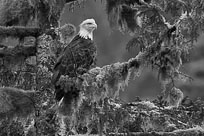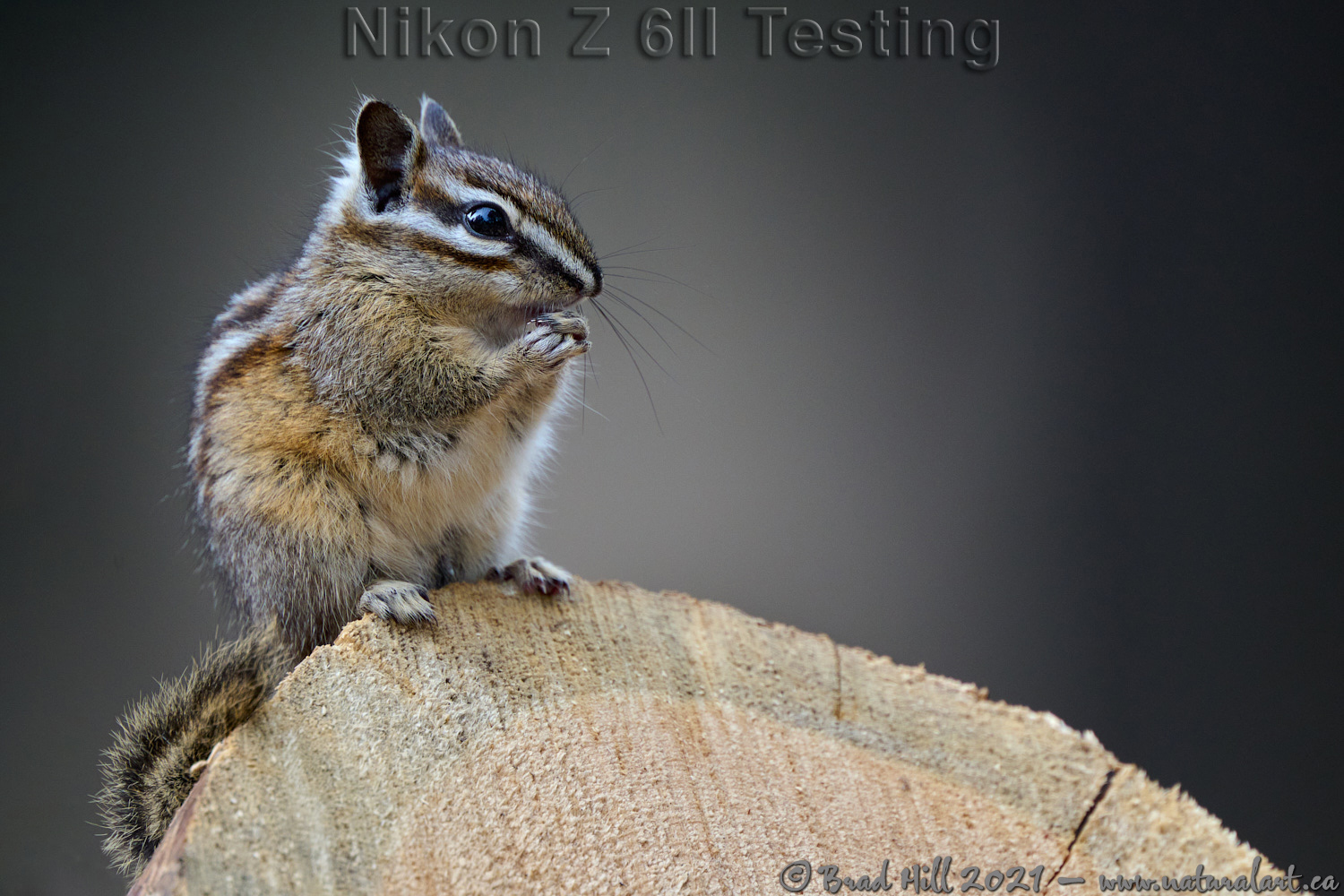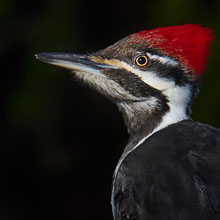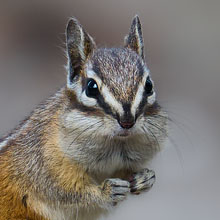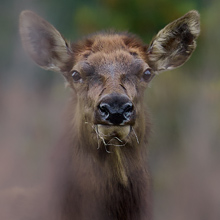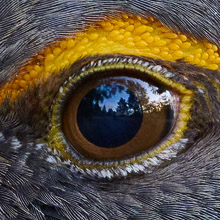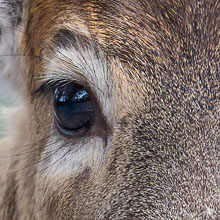Availability: Undetermined - Enquiries?
In the Field
Z 6II Testing - Yellow-pine Chipmunk: 180-400 plus 2x TC. Findlay Creek Region (East Kootenays), British Columbia, Canada. April 9, 2021.
This is my fifth gallery post and commentary describing my experiences with shooting wildlife using the Nikon Z 6II. In earlier shooting with the Z 6II (and the Z 7II) I had discovered that the new Z series mirrorless cameras performed incredibly well with both the 1.4x and 2x teleconverters when shooting them with the 500mm f5.6E PF lens. Now...I have shot and tested teleconverters extensively with a lot of Nikon's top super-telephoto lenses on Nikon's DSLR's and have found that there was a LOT of variability in performance depending on the lens you paired a TC with. The combination I was MOST comfortable shooting in the field was the Nikkor 400mm f2.8E plus the 1.4x (TC-14EIII) teleconverter. I also found that the Nikkor 400mm f2.8E paired up pretty well with the 2x (TC-20EIII) teleconverter...but the hit rate was quite low and the AF speed took a pretty big hit.
So...being a curious kind of guy, I wondered if the excellent results I had been obtaining with the Z 6II plus 500 PF and BOTH the 1.4x and 2.0x TC's was because I had hit on a lens that just happened to love TC's or if...perhaps...it was a general trend with the Z-bodies. (As an aside...in the past I have shot the 500mm PF plus 1.4x TC on my D5 and on my D6 and had got only "iffy" results, with a pretty low hit rate...so I was already thinking that the Zed's might simply "do better" with TC's than Nikon's DSLR's do). So I decided to shoot the Z 6II with some other lens/TC combinations that I had previously tried with my D5 and D6 and I knew didn't work well with DSLR's.
SO...cue the readily available test subjects! This cute little Yellow-pine Chipmunk was captured with Nikon's amazing 180-400mm f4E lens plus the TC-20EIII (2x) teleconverter (with the lens's internal 1.4x TC NOT engaged). I had previously tested this lens/TC combination with my D5 and my D6 and had decided it fit into the "NEVER shoot with this combination" category. BUT...with the Z 6II (and also the Z 7II) the 180-400 plus 2x TC produced optically excellent results! Yes, the speed of the AF system did fall some (compared to shooting the lens on the Z 6II with NO TC or with the built-in TC engaged), but it was more than adequate to capture lots of sharp shots with these speedy subjects. Hmmm...interesting...
So...then I decided to try another lens/TC combination on my Z 6II that I knew produced REALLY iffy results (i.e., BAD) when shot with a D5 or D6. That was the 180-400mm f4E with its built-in 1.4x TC engaged PLUS a TC-14EIII (1.4x) TC. Because a 1.4x TC is really a "square root of 2" teleconverter (1.4142...X), I knew that by stacking the internal 1.4x TC with the TC-14EIII (1.4x) TC I would have the exact equivalent magnification of shooting the 180-400 with a 2x TC. The result? Shockingly good! Anecdotally I THINK I got very slightly better results with the 180-400 with the 2x TC than I did with the 180-400 with the 1.4x plus 1.4x TC stack, but that's based on too few samples to say definitively. AF performance on the 1.4x TC stack seemed to be about the same as when I shot the 180-400 with the 2x TC. I have posted a 2400 pixel sample of an image captured with the 1.4x TC stack below.
So...of course...the next logical step was to try the Z 6II with the 180-400mm f4E with its built-in 1.4x TC engaged PLUS the TC-20EII. Well...it did still focus! But...in terms of optical results...well...in a pinch, for a documentary shot...maybe! But I don't think you'll ever see any shots posted on this website shot with this combination! There are still some limitations we can't get around! ;-)
Here's a larger version (2400 pixel) of this cute little chipper:
• Yellow-pine Chipmunk: 180-400 plus 2x TC: Download 2400 pixel image (JPEG: 1.5 MB)
And here's another larger version (2400 pixel) of a chipper, but this time with the 180-400 plus a 1.4x TC "stack":
• Yellow-pine Chipmunk: 180-400 TC "Stack": Download 2400 pixel image (JPEG: 2.0 MB)
ADDITIONAL NOTES:
1. These images - in all resolutions - are protected by copyright. I'm fine with personal uses of them (including use as desktop backgrounds or screensavers on your own computer), but unauthorized commercial use of the image is prohibited by law. Thanks in advance for respecting my copyright!
2. Like all photographs on this website, this image was captured following the strict ethical guidelines described in The Wildlife FIRST! Principles of Photographer Conduct. I encourage all wildlife photographers to always put the welfare of their subjects above the value of their photographs.
Behind the Camera
Z 6II Testing - Yellow-pine Chipmunk: 180-400 plus 2x TC. Findlay Creek Region (East Kootenays), British Columbia, Canada. April 9, 2021.
Compressed RAW (NEF) 14-bit format; ISO 1800.
Nikon Z 6II paired with Nikkor 180-400mm f4E PF plus TC-20EIII (2x) teleconverter (for a total focal length of 800mm). Hand-held. VR on and in Normal mode. Single Point Area AF area mode.
1/400s @ f8; no compensation from matrix-metered exposure setting.
At the Computer
Z 6II Testing - Yellow-pine Chipmunk: 180-400 plus 2x TC. Findlay Creek Region (East Kootenays), British Columbia, Canada. April 9, 2021.
RAW Conversion to 16-bit PSD file (and JPEG files for web use), including all global and selective adjustments, using Phase One's Capture One Pro 21. Global adjustments on this image were limited to a tweak to contrast (levels adjustment) and highlights. Selective local adjustments performed using Capture One Pro's layers and masking tools. In this case selective adjustments were made on 4 separate layers and included one or more tweaks to sharpness, color saturation, blacks, and shadows.
Photoshop modifications were limited to the insertion of the watermark and/or text.
Conservation
Z 6II Testing - Yellow-pine Chipmunk: 180-400 plus 2x TC. Findlay Creek Region (East Kootenays), British Columbia, Canada. April 9, 2021.
Species Status in Canada*: This species is not designated as at risk.
The Yellow-pine Chipmunk (Tamias amoenus) occupies the widest array of habitat types of any chipmunk in British Columbia, including lowland forests, arid-steppe grasslands, through to sub-alpine forests and alpine meadows. And, they're found from sea level up to an elevation of up to 2300 meters. Geographically their range includes from California and Nevada north to British Columbia and western Alberta.
With its wide range of habitats also comes a diet with a wide variety of foods. They eat fungi, a huge range of plant material, insects and other invertebrates, and even birds eggs. In turn, they are the prey of Red-tailed Hawks, American Badgers, Long-tailed Weasels, Bobcats, Coyotes, among other opportunistic predators.
Studies and reports of the populations of Yellow-pine Chipmunks are few and far between, but there's no evidence that their numbers are declining or that their geographic range is shrinking.
*as determined by COSEWIC: The Committee on the Status of Endangered Wildlife in Canada










